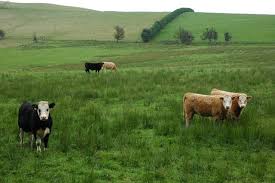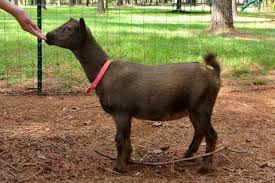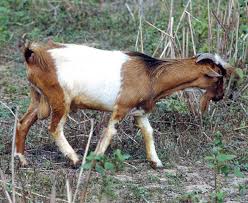Previous issue | Next issue | Archive
Volume 8 (5); September 25, 2018 [Booklet]
Productive responses of grazing cows to feed supplementation in the Coastal Savannah zone of Ghana.
Obese F, Adjorlolo LK and Dwumah K.
Online J. Anim. Feed Res., 8(4): 105-111, 2018; pii: S222877011800014-8
Abstract
Daily weight gains, body condition score (BCS), milk yield, concentrations of blood metabolites and resumption of ovarian activity were evaluated in 10 Sanga and 10 Friesian-Sanga cows grazing on natural pasture and supplemented with 2.5 kg of concentrate a day for 10 weeks during the dry season. Average daily gain in weight was similar in the Sanga (293 g) and Friesian-Sanga crossbred (288 g). Body condition score was also similar in the two breeds, but Friesian-Sanga cows had higher milk yield than Sanga cows (2.23 vs 1.65 L/day; P < 0.001). There were no significant differences in the concentrations of all the plasma metabolites determined apart from albumin and cholesterol concentrations. Albumin concentration was significantly higher in the Friesian-Sanga crossbred cows than Sanga cows (31.0 vs 29.3 g/L; P < 0.05), but total cholesterol was significantly higher in the Sanga than the Friesian-Sanga crossbreds (2.33 vs 2.01 mmol/L; P < 0.01). The two breeds had similar interval from calving to resumption of ovarian activity and proportion of non-cycling cows. The results from this study indicate the beneficial effects of feed supplementation on milk yield in Friesian-Sanga cows. Further studies need to be carried out to determine the effects of feed supplementation on milk composition and concentrations of metabolic hormones such as insulin, insulin-like growth factor-1 and leptin that mediate the effects of nutrition on ruminant reproduction.
Keywords: Blood metabolite, Coastal Savannah, Dry Season, Nutrition, Ovarian Activity
[Full text-PDF]
Research Paper
Composition of colostrum and milk of West African Dwarf (WAD) does fed cassava peel based- diets supplemented with African yambean (Sphenostylis stenocarpa) concentrate in the humid zone of Nigeria.
Anya MI and Ozung PO.
Online J. Anim. Feed Res., 8(5): 112-119, 2018; pii: S222877011800015-8
Abstract
Twelve pregnant West African Dwarf (WAD) does were used to determine the effect of cassava peel meal based diets supplemented with African yambean Meal (AYBM) concentrate on colostrum and milk yield composition. Four concentrate diets were formulated with AYBM at 0, 10, 20 and 30% levels designated as T1, T2, T3 and T4, respectively. The does were randomly assigned into four groups of three per treatment and assigned to the respective diets in a Completely Randomized Design (CRD) experiment. Lactation length for each doe was based on 135 days. Results showed that daily colostrum yield, total solids (TS), crude protein (CP), ash and energy compositions differed significantly (P<0.05) between the treatment groups. The mean colostrum yield per day (15.68 g), TS (18.52 %) and CP (5.41 %) were highest in diet T3 (20% AYBM) than treatment T2 (10% AYBM). Diet T4 (30% AYBM) promoted the highest percent values for Butterfat (BF), solids-non-fat (SNF), ash and energy with values of 3.52%, 14.54%, 0.91% and 4.30MJ/Kg, respectively. Milk yield, TS, BF, CP, SNF, ash and energy composition differed significantly (P<0.05) between treatment groups. Milk yield (3.26 kg), SNF (9.96%) and energy constituent (3.91MJ/kg) values were highest for does fed 10% AYBM diet, while Diet T4 (30% AYBM) promoted the highest TS, BF, CP and ash and the values were 15.03, 5.49, 4.89 and 1.04%, respectively. The study concludes that cassava peel meal based – diets supplemented with African yambean concentrate supported optimum colostrum and milk composition without deleterious effects. The study therefore recommends that 20% inclusion level of African yambean concentrate in cassava peel meal based- diets is ideal for effective colostrum yield and milk composition in West African Dwarf does.
Keywords: African Yambean, Colostrum, Milk Yield, Milk Composition, WAD Does
[Full text-PDF]
Hide and skin quality factors and marketing systems in Gondar town, Ethiopia
Ayalew H, Tamiru E and Nega Y.
Online J. Anim. Feed Res., 8(5): 120-125, 2018; pii: S222877011800016-8
Abstract
The study was conducted with the objective of assessing the type of defect affecting quality and marketing systems of hide and skin in Gondar town. Four kebeles were selected purposively based on intensity of fattening, degree of slaughtering frequency and number of hide and skin collection and traditional processing center and 15 household from each kebeles (a total of 60) were interviewed. Data were collected by developing semi structured questionnaires and direct observation. Collected data was organized, summarized and analyzed using SPSS version 20. The result indicated that all (100%) of examined hide and skin had one or more types of pre and post slaughter defects. The major types of pre slaughter defects responsible for the decline in quality of hide and skin were by ecto parasite (28.3), yolk mark (15 %), bloat surgery (31.7%), horn rake (6.7%), rope mark (8.3), branding (5%) and the rest 5% were thorn scratches. The finding also revealed that post slaughter defects were flaying cut (51.7%), poor pattern (13.3), putrefaction (16.7%) and improper fleshing (18.3%). Most of the respondents (95%) absence of defect, freshness and size were used as criteria for assessing the quality of hide and skin. It was observed that marketing was accomplished at four levels: producer, middlemen, collection center and tannery. Majority (75%) of respondents reported to sold hide and skin to the formal market for their cash income. Producers were price takers and buyers had power on price determination. It can be concluded that the both pre and post-slaughter defects have the potential to reduce quality of hide and skin. So, training should be given for livestock holders and market actors since most of the defect can be avoided through careful management of the animal, hide and skin.
Keywords: Defects, Gondar, Hide and Skin, Marketing, Quality factors
[Full text-PDF]
The effect of essential oil combination on bio-hydrogenation of polyunsaturated fatty acids on West African Dwarf goats.
Eburu PO and Anya MI.
Online J. Anim. Feed Res., 8(5): 126-135, 2018; pii: S222877011800017-8
Abstract
A study was conducted at the Teaching and Research farm of the University of Calabar, Cross River State, Nigeria, on the effect of essential oil (EO) combination on bio-hydrogenation (BH) of n-3 polyunsaturated fatty acids (PUFAs) and fermentation activities of rumen microbes. Four West African Dwarf goats (mean weight 40.0 ±2.5kg) were offered grass (Panicum maximum) and water ad libitum and supplemented with additional 400 g/goat/day of goat pellets for a period of 14 days. A basal feedstock comprising of 70:30 grass hay and concentrate was formulated. Each serum bottles contained 20 ml inoculum, 80 ml buffer, 1 g of feed substrate and supplemented with 300 mg/l of EO or their combination and incubated at 39⁰C for 48 h, and samples were collected to analyse ammonia N, total volatile fatty acids (TVFA) and concentration of PUFAs using GenStat 16th edition. There were four treatments and eight replicates as follows: Control, anise oil, lavender oil and blend (150 mg:150 mg) of anise and lavender (A+LO). Relative to the control, anise oil was the only treatment that reduced (P<0.001) ammonia N concentration in culture by a magnitude of 66% at 24 h. The concentration of TVFA (mM) was reduced by anise oil, whilst all other treatments maintained this level relative to the control (68.3, 60.4, 67.7 and 66.1 mM, for the control, anise oil, lavender oil and A+LO, respectively). The concentrations of n-3 PUFAs and C18:2 n-6 were maintained at higher levels (P<0.001) with addition of all EO, but were highest (P<0.001) in cultures where anise oil was added. The concentrations of 18:2 cis-9 trans 11 conjugated linoleic acid (CLA) and C18:1 trans 11 were significantly maintained (P<0.001) at higher levels by anise and A+LO. At both time points, the concentration of C18:0 was lowest in the control and highest in cultures supplemented with EOs. This study indicates that combining anise and lavender oil (at 1:1 ratio) substantially reduced bio-hydrogenation but without a considerable suppression of ruminal VFA concentration. Hence, this study recommends that, if this effect is confirmed in vivo, using anise and lavender oil (at levels 1:1) could reduce ruminal bio-hydrogenation without affecting ruminal volatile fatty acid concentration.
Keywords: Essential oils, Polyunsaturated fatty acids, Rumen fermentation, Volatile fatty acids
[Full text-PDF]
Previous issue | Next issue | Archive
This work is licensed under a Creative Commons Attribution-NonCommercial 4.0 International License.
| < Prev | Next > |
|---|







